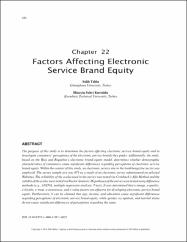Factors Affecting Electronic Service Brand Equity
Erişim
info:eu-repo/semantics/closedAccessTarih
2013-11Erişim
info:eu-repo/semantics/closedAccessÜst veri
Tüm öğe kaydını gösterÖzet
The purpose of this study is to determine the factors affecting electronic service brand equity and to investigate consumers’ perceptions of the electronic service brands they prefer. Additionally, the study, based on the Rios and Riquelme’s electronic brand equity model, determines whether demographic characteristics of consumers cause significant differences regarding perceptions of electronic service brand equity. Within the context of this study, an electronic service site in the book/magazine sector was employed. The survey sample size was 675 as a result of an electronic survey administered on selected Websites. The reliability of the scales used in the survey was tested via Cronbach’s Alfa Method and the validity of the scales were tested via Factor Analysis. Hypotheses of the survey were tested using difference methods (e.g., ANOVA, multiple regression analysis, T-test). It was determined that e-image, e-quality, e-loyalty, e-trust, e-awareness, and e-value factors are effective for developing electronic service brand equity. Furthermore, it can be claimed that age, income, and education cause significant differences regarding perceptions of electronic service brand equity, while gender, occupation, and marital status do not cause significant differences of perceptions regarding the same.


















